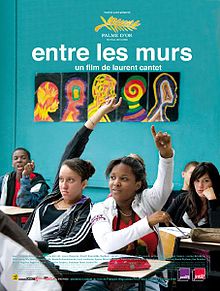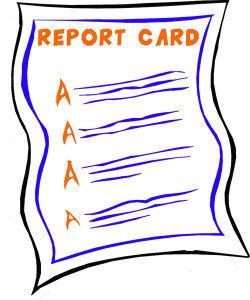 Although many AP language teachers design excellent curricula by treating each AP theme in a linear way, I have chosen a slightly different approach. Rather than designing my units around the themes or subthemes, I have designed each one around a film, and then woven the AP subthemes throughout the lessons for each film. The interlocking circle diagram used by the College Board clearly supports the interconnectedness of the themes and my syllabus was approved during the audit process, so I’m confident that this approach is appropriate for my students. Successful results on the AP test and increased enrollment in my French 4/5 class has provided further support for this curricular design.
Although many AP language teachers design excellent curricula by treating each AP theme in a linear way, I have chosen a slightly different approach. Rather than designing my units around the themes or subthemes, I have designed each one around a film, and then woven the AP subthemes throughout the lessons for each film. The interlocking circle diagram used by the College Board clearly supports the interconnectedness of the themes and my syllabus was approved during the audit process, so I’m confident that this approach is appropriate for my students. Successful results on the AP test and increased enrollment in my French 4/5 class has provided further support for this curricular design.
This year, the first unit in my AP class will be designed around the film, Entre les Murs. Although the central topic of this unit will be Education (a subtopic of Contemporary Life), this film also addresses the following AP subthemes:
- Diversity Issues (Global Challenges)
- Economic Issues (Global Challenges)
- Human Rights (Global Challenges)
- Leisure and Sports (Contemporary Life)
- Rites of Passage (Contemporary Life)
- Professions (Contemporary Life)
- Alienation and Assimilation (Personal and Public Identities)
- Beliefs and Values (Personal and Public Identities)
- Gender and Sexuality (Personal and Public Identities)
- Language and Identity (Personal and Public Identities)
- Multiculturalism (Personal and Public Identities)
- Nationalism and Patriotism (Personal and Public Identities)
- Age and Class (Families and Communities)
- Childhood and Adolescence (Families and Communities)
- Citizenship (Families and Communities)
- Family Structures (Families and Communities)
- Performing arts (Beauty and Aesthetics)
Before watching the film, my students will complete a series of learning activities designed to provide them with the necessary background knowledge to comprehend and discuss the film. Following the explanation below, you will find a link to a 24-page packet of activities that I will distribute to my students at the beginning of the unit.
Lesson 1: Because this will be the first lesson of the 2015-2016 school year, my goals were to engage my students, get them communicating in French after the long break, and provide opportunities to review the structures required to narrate past events—an important expectation for Intermediate High students. In order to meet these goals I selected an authentic article from Phosphore magazine in which several teenagers tell about their favorite vacation memory. In this lesson my students will complete a comprehension guide for this article, discuss their own vacation memories in small groups, write an article about their own vacation memory, listen to a video about low-cost vacations, discuss the video, write a blog entry encouraging French tourists to travel to our community and then prepare an oral presentation on the same topic. Here are the pdf’s of the article: souvenir p.1souvenir p. 2souvenir p. 3souvenir p. 4
Lesson 2: In this lesson the students will look at a diagram/short article which describes the grade levels and exams which are included in the French school system. This is important background information for further resources used in later lessons which will refer to grade levels and exams. After a short discussion, the students will prepare a written and/or oral presentation comparing the two systems. Finally, they will watch a Cyprien YouTube video and complete a related interpersonal and presentational activity.
Lesson 3: I designed this lesson to activate my students’ background knowledge about the Bac. Although this important exam will not play a role in the film (whose students are middle school-aged), I think it’s important for my students to be familiar with this aspect of the French educational system. Therefore, in this lesson the students will watch a short video as a hook to the lesson, read and discuss a brief infographic with statistics about the Bac, watch a news video with students’ reactions to their Bac results, and then discuss differences between the Bac and American college entrance exams. Lastly, they will read a comic strip about the Bac, prepare an oral summary of the story and then write an e-mail explaining the differences between the Bac and ACT/SAT. Here’s the comic: le Bac
Lesson 4: In this lesson the students will be become familiar with slam poetry by watching and discussing the video, “Education Nationale” by Grand Corps Malade. In addition to introducing the students to this art form, this video addresses some of the educational topics that will be presented in Entre les Murs.
Lesson 5: Finally—it’s time for the show! For the next five class periods the students will watch and discuss the film. In the packet I’ve provided a glossary, as well as questions that can be used to assess comprehension and promote discussion. During each “movie day” I will show about 30 minutes of film (which I will frequently pause to ask questions and check for understanding) and about 15 min. of conversational activities. This conversation might include the questions in the packet, role plays, and “Controversial Statements” (see below). When designing role plays, I usually describe a hypothetical situation that the students will spontaneously perform. Here are some examples from the film.
#1
A: You and M. Marin and you’ve just come home from your first day of school. Your partner wants to know all about your day. Tell him/her about your day and your feelings about it.
B: You are M. Marin’s partner and today was his first day of school. Find out all about his day including what his students and any new colleagues are like.
#2
A: You and your partner are each students in M. Marin’s class. Talk about how your school year is going and what you think of M. Marin and his class.
B: You and your partner are each students in M. Marin’s class. Talk about how your school year is going and what you think of M Marin and his class.
#3
A: You are Khoumba’s mother. She has just brought home her “Carnet de Correspondance” with M. Marin’s comments about her behavior in class. Ask her about what happened. It’s up to you whether you will take her side or her teacher’s.
B: You are Khoumba and you’ve just shown your “Carnet de Correspondance” to your mother. Explain your side of the story.
#4
A: You are Wei’s mom or dad and you’ve just come home from your parent-teacher conference with M. Marin. Talk to Wei about what M. Marin had to say.
B: You are Wei and your mom/dad has just come home from their parent-teacher conference with M. Marin. Respond to your parent’s comments.
#5
A: You are Souleymane’s mom and you’ve just received a phone call from the school principal. Talk to Souleymane about what the principal said and what you expect him to do to change his behavior. Tell him what the consequences will be if his behavior doesn’t improve.
B: You are Souleymane and your mom has just gotten off the phone with the principal. She’s pretty angry with you so you will try to defend yourself.
#6
A: You are Khoumba and you’ve just come home with a cut above your eye. Your mom wants to know what happened, so tell her.
B: You are Khoumba’s mom and you want to know why Khoumba has a cut above her eye. It’s up to you to decide what you will do when you find out what happened.
#7
A: You are Esmerelda and you’re angry with M. Marin for calling you a name. You’ve decided to go to the principal about what happened.
B: You are the principal and Esmerelda has just told you about an incident with M. Marin. Find out more about the situation so you can decide how to handle it.
#8
A: You are Khoumba and you’ve just heard about Souleymane’s punishment. You feel really bad about it so you go and talk to him.
B: You are Souleymane and you’ve just been expelled. Khoumba has come over to tell you how sorry she is about what happened. How will you react?
“Controversial Statements”
For this activity, I project a series of statements (one at a time) and the students discuss each one in small groups for 3-5 minutes. To add an additional dimension to the conversation, students earn “points” for the type of contributions that they make to the discussion. This system of points came from a resource I was given several years ago. Unfortunately, I can’t remember the exact wording for each level—my apologies to the creator!
1 – Makes a statement of fact
2 – Supports another’s opinion
3 – Asks a question
4 – Provides a dissenting opinion
5 – Unexpected provocation
I assign one student in each small group to be the scorekeeper who will make a note of how many points each person earns. While I don’t actually assign the points that each student earns (in order to avoid pressure on the scorekeeper to fudge the scores), I find that this system really challenges my students to increase the depth of their discussions. Here are some controversial statements I might use for this film.
- M. Marin est un bon professeur.
- M. Marin charrie trop.
- Un système disciplinaire avec des points est une bonne idée.
- Il est important que les professeurs aient une cafetière.
- M. Marin est raciste.
- Il est importants que des élèves participent come délégués aux conseils de classe.
- C’est la faute de M. Marin que Souleymane a été exclu.
- Marin regrette ce qu’il a dit à Esmerelda.
- Le proviseur devrait virer M. Marin.
- Souleymane mérite son exclusion.
- Henriette devrait aller à un lycée professionnel.
I may also have the students discuss some of these statements as homework on our class forum. This would give them an opportunity to engage in written interpersonal communication, a skill that I often overlook in designing my lessons.
Note: I haven’t seen the film in a couple of years, so I will be able to add more specific role plays and controversial statements after re-watching the film.
Click here for the activity packet for this unit: Unit 1 Packet
Integrated Performance Assessment
After watching the film, my students will take the summative assessment for the unit—an IPA composed of the following tasks:
Interpretive Reading: The students will read an article about an educational reform related to ZEP schools (like Dolto). I designed the interpretive task to mimic as closely as possible the question types found on the AP exam, while at the same time trying to address some issues I’ve had when designing previous AP-style questions. Namely, I have found that my students are less likely to read carefully when presented with multiple choice questions. I have tried various ways of addressing this problem in the past, and these are the modifications that I’m trying on this assessment:
- I’ve required the students to underline the sentence(s) in the text where they found the response (for literal level questions)
- I’ve required the students to justify their responses to inference and culture-based questions by writing supporting information.
Interpretive Listening: The students will watch a news video about the ZEP/REP reform and respond to multiple choice questions.
Interpersonal Communication: The students will play the roles of two teachers at Dolto who are discussing how the ZEP/REP reform would affect various students in the school.
Presentational Writing: Students (acting as a Dolto teacher) will write a letter to the French Minister of Education, requesting they be given REP status and explaining why their students need smaller classes and extra help.
Click here for a copy of the IPA: unit 1 IPA
Here’s a tentative agenda for this unit: unit 1 outline
I’d love to hear back from you about how you incorporate film in your upper-level classes!
 As promised in an earlier post, I’ve prepared an IPA for the vacation unit I developed for my French 3 students. Before administering the IPA, though, I want to make sure that my students are prepared for the types of tasks they’ll be asked to perform. Therefore, I’ve created a series of learning stations (Vacation Stations) that the students will complete during the four days preceding the IPA.
As promised in an earlier post, I’ve prepared an IPA for the vacation unit I developed for my French 3 students. Before administering the IPA, though, I want to make sure that my students are prepared for the types of tasks they’ll be asked to perform. Therefore, I’ve created a series of learning stations (Vacation Stations) that the students will complete during the four days preceding the IPA.

 In conversations about Integrated Performance Assessments, my fellow teachers often share their concerns about using authentic texts with beginners. There seems to be a widespread belief that true beginners cannot derive meaning from texts created by native speakers for native speakers. I hope that these assessments, which will be implemented during the unit I shared in
In conversations about Integrated Performance Assessments, my fellow teachers often share their concerns about using authentic texts with beginners. There seems to be a widespread belief that true beginners cannot derive meaning from texts created by native speakers for native speakers. I hope that these assessments, which will be implemented during the unit I shared in 





